Caijun Zhong
Beamforming Design for Semantic-Bit Coexisting Communication System
Mar 22, 2024



Abstract:Semantic communication (SemCom) is emerging as a key technology for future sixth-generation (6G) systems. Unlike traditional bit-level communication (BitCom), SemCom directly optimizes performance at the semantic level, leading to superior communication efficiency. Nevertheless, the task-oriented nature of SemCom renders it challenging to completely replace BitCom. Consequently, it is desired to consider a semantic-bit coexisting communication system, where a base station (BS) serves SemCom users (sem-users) and BitCom users (bit-users) simultaneously. Such a system faces severe and heterogeneous inter-user interference. In this context, this paper provides a new semantic-bit coexisting communication framework and proposes a spatial beamforming scheme to accommodate both types of users. Specifically, we consider maximizing the semantic rate for semantic users while ensuring the quality-of-service (QoS) requirements for bit-users. Due to the intractability of obtaining the exact closed-form expression of the semantic rate, a data driven method is first applied to attain an approximated expression via data fitting. With the resulting complex transcendental function, majorization minimization (MM) is adopted to convert the original formulated problem into a multiple-ratio problem, which allows fractional programming (FP) to be used to further transform the problem into an inhomogeneous quadratically constrained quadratic programs (QCQP) problem. Solving the problem leads to a semi-closed form solution with undetermined Lagrangian factors that can be updated by a fixed point algorithm. Extensive simulation results demonstrate that the proposed beamforming scheme significantly outperforms conventional beamforming algorithms such as zero-forcing (ZF), maximum ratio transmission (MRT), and weighted minimum mean-square error (WMMSE).
Deep Learning-based Design of Uplink Integrated Sensing and Communication
Mar 03, 2024Abstract:In this paper, we investigate the issue of uplink integrated sensing and communication (ISAC) in 6G wireless networks where the sensing echo signal and the communication signal are received simultaneously at the base station (BS). To effectively mitigate the mutual interference between sensing and communication caused by the sharing of spectrum and hardware resources, we provide a joint sensing transmit waveform and communication receive beamforming design with the objective of maximizing the weighted sum of normalized sensing rate and normalized communication rate. It is formulated as a computationally complicated non-convex optimization problem, which is quite difficult to be solved by conventional optimization methods. To this end, we first make a series of equivalent transformation on the optimization problem to reduce the design complexity, and then develop a deep learning (DL)-based scheme to enhance the overall performance of ISAC. Both theoretical analysis and simulation results confirm the effectiveness and robustness of the proposed DL-based scheme for ISAC in 6G wireless networks.
Bayesian Learning for Double-RIS Aided ISAC Systems with Superimposed Pilots and Data
Feb 16, 2024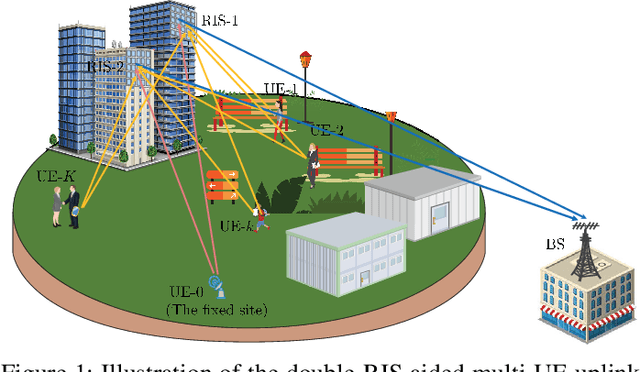
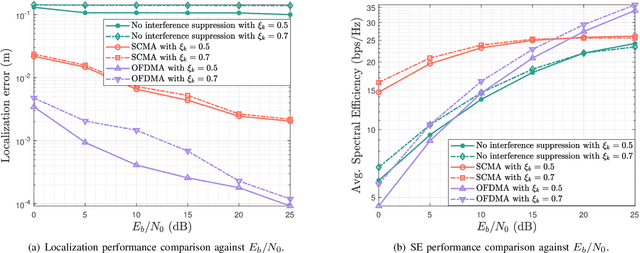
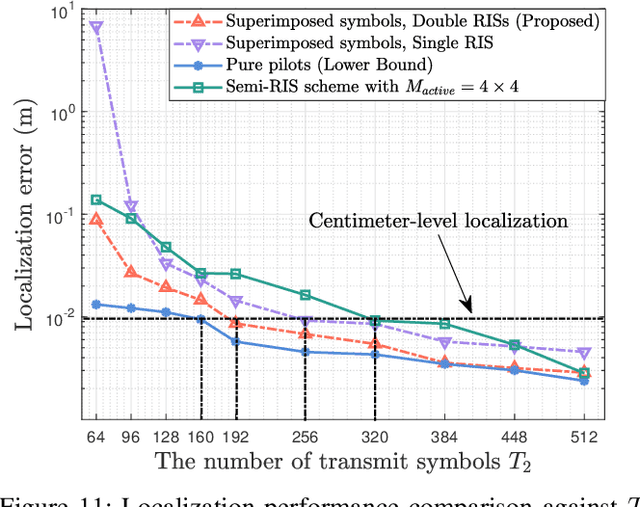
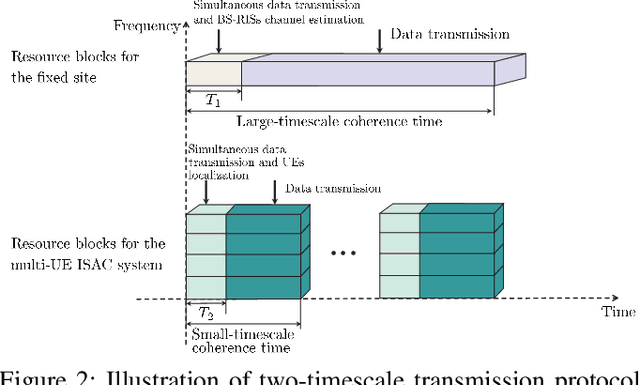
Abstract:Reconfigurable intelligent surface (RIS) has great potential to improve the performance of integrated sensing and communication (ISAC) systems, especially in scenarios where line-of-sight paths between the base station and users are blocked. However, the spectral efficiency (SE) of RIS-aided ISAC uplink transmissions may be drastically reduced by the heavy burden of pilot overhead for realizing sensing capabilities. In this paper, we tackle this bottleneck by proposing a superimposed symbol scheme, which superimposes sensing pilots onto data symbols over the same time-frequency resources. Specifically, we develop a structure-aware sparse Bayesian learning framework, where decoded data symbols serve as side information to enhance sensing performance and increase SE. To meet the low-latency requirements of emerging ISAC applications, we further propose a low-complexity simultaneous communication and localization algorithm for multiple users. This algorithm employs the unitary approximate message passing in the Bayesian learning framework for initial angle estimate, followed by iterative refinements through reduced-dimension matrix calculations. Moreover, the sparse code multiple access technology is incorporated into this iterative framework for accurate data detection which also facilitates localization. Numerical results show that the proposed superimposed symbol-based scheme empowered by the developed algorithm can achieve centimeter-level localization while attaining up to $96\%$ of the SE of conventional communications without sensing capabilities. Moreover, compared to other typical ISAC schemes, the proposed superimposed symbol scheme can provide an effective throughput improvement over $133\%$.
Spectrum Sharing between UAV-based Wireless Mesh Networks and Ground Networks
Nov 25, 2023Abstract:The unmanned aerial vehicle (UAV)-based wireless mesh networks can economically provide wireless services for the areas with disasters. However, the capacity of air-to-air communications is limited due to the multi-hop transmissions. In this paper, the spectrum sharing between UAV-based wireless mesh networks and ground networks is studied to improve the capacity of the UAV networks. Considering the distribution of UAVs as a three-dimensional (3D) homogeneous Poisson point process (PPP) within a vertical range, the stochastic geometry is applied to analyze the impact of the height of UAVs, the transmit power of UAVs, the density of UAVs and the vertical range, etc., on the coverage probability of ground network user and UAV network user, respectively. The optimal height of UAVs is numerically achieved in maximizing the capacity of UAV networks with the constraint of the coverage probability of ground network user. This paper provides a basic guideline for the deployment of UAV-based wireless mesh networks.
Sensing-based Beamforming Design for Joint Performance Enhancement of RIS-Aided ISAC Systems
Jun 08, 2023Abstract:Reconfigurable intelligent surface (RIS) has shown its great potential in facilitating device-based integrated sensing and communication (ISAC), where sensing and communication tasks are mostly conducted on different time-frequency resources. While the more challenging scenarios of simultaneous sensing and communication (SSC) have so far drawn little attention. In this paper, we propose a novel RIS-aided ISAC framework where the inherent location information in the received communication signals from a blind-zone user equipment is exploited to enable SSC. We first design a two-phase ISAC transmission protocol. In the first phase, communication and coarse-grained location sensing are performed concurrently by exploiting the very limited channel state information, while in the second phase, by using the coarse-grained sensing information obtained from the first phase, simple-yet-efficient sensing-based beamforming designs are proposed to realize both higher-rate communication and fine-grained location sensing. We demonstrate that our proposed framework can achieve almost the same performance as the communication-only frameworks, while providing up to millimeter-level positioning accuracy. In addition, we show how the communication and sensing performance can be simultaneously boosted through our proposed sensing-based beamforming designs. The results presented in this work provide valuable insights into the design and implementation of other ISAC systems considering SSC.
Over-the-Air Federated Edge Learning with Error-Feedback One-Bit Quantization and Power Control
Mar 20, 2023



Abstract:Over-the-air federated edge learning (Air-FEEL) is a communication-efficient framework for distributed machine learning using training data distributed at edge devices. This framework enables all edge devices to transmit model updates simultaneously over the entire available bandwidth, allowing for over-the-air aggregation. A one-bit digital over-the-air aggregation (OBDA) scheme has been recently proposed, featuring one-bit gradient quantization at edge devices and majority-voting based decoding at the edge server. However, the low-resolution one-bit gradient quantization slows down the model convergence and leads to performance degradation. On the other hand, the aggregation errors caused by fading channels in Air-FEEL is still remained to be solved. To address these issues, we propose the error-feedback one-bit broadband digital aggregation (EFOBDA) and an optimized power control policy. To this end, we first provide a theoretical analysis to evaluate the impact of error feedback on the convergence of FL with EFOBDA. The analytical results show that, by setting an appropriate feedback strength, EFOBDA is comparable to the Air-FEEL without quantization, thus enhancing the performance of OBDA. Then, we further introduce a power control policy by maximizing the convergence rate under instantaneous power constraints. The convergence analysis and optimized power control policy are verified by the experiments, which show that the proposed scheme achieves significantly faster convergence and higher test accuracy in image classification tasks compared with the one-bit quantization scheme without error feedback or optimized power control policy.
On the $f$-Differential Privacy Guarantees of Discrete-Valued Mechanisms
Feb 19, 2023
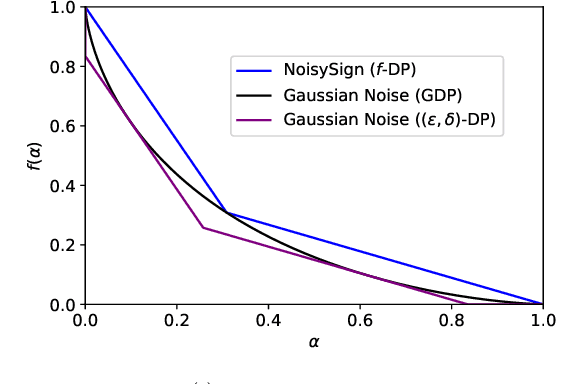


Abstract:We consider a federated data analytics problem in which a server coordinates the collaborative data analysis of multiple users with privacy concerns and limited communication capability. The commonly adopted compression schemes introduce information loss into local data while improving communication efficiency, and it remains an open question whether such discrete-valued mechanisms provide any privacy protection. Considering that differential privacy has become the gold standard for privacy measures due to its simple implementation and rigorous theoretical foundation, in this paper, we study the privacy guarantees of discrete-valued mechanisms with finite output space in the lens of $f$-differential privacy (DP). By interpreting the privacy leakage as a hypothesis testing problem, we derive the closed-form expression of the tradeoff between type I and type II error rates, based on which the $f$-DP guarantees of a variety of discrete-valued mechanisms, including binomial mechanisms, sign-based methods, and ternary-based compressors, are characterized. We further investigate the Byzantine resilience of binomial mechanisms and ternary compressors and characterize the tradeoff among differential privacy, Byzantine resilience, and communication efficiency. Finally, we discuss the application of the proposed method to differentially private stochastic gradient descent in federated learning.
Magnitude Matters: Fixing SIGNSGD Through Magnitude-Aware Sparsification in the Presence of Data Heterogeneity
Feb 19, 2023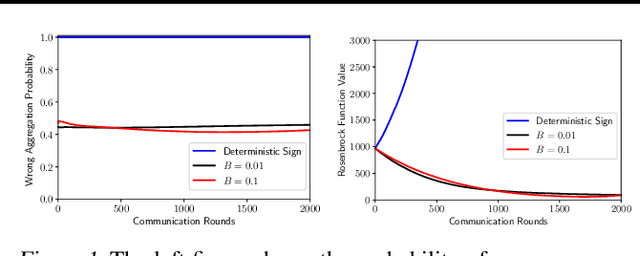


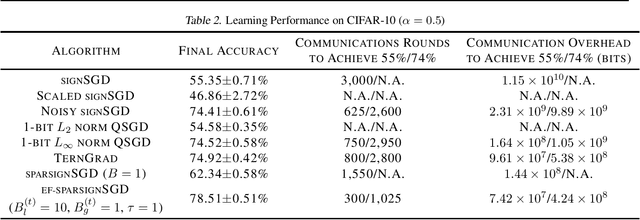
Abstract:Communication overhead has become one of the major bottlenecks in the distributed training of deep neural networks. To alleviate the concern, various gradient compression methods have been proposed, and sign-based algorithms are of surging interest. However, SIGNSGD fails to converge in the presence of data heterogeneity, which is commonly observed in the emerging federated learning (FL) paradigm. Error feedback has been proposed to address the non-convergence issue. Nonetheless, it requires the workers to locally keep track of the compression errors, which renders it not suitable for FL since the workers may not participate in the training throughout the learning process. In this paper, we propose a magnitude-driven sparsification scheme, which addresses the non-convergence issue of SIGNSGD while further improving communication efficiency. Moreover, the local update scheme is further incorporated to improve the learning performance, and the convergence of the proposed method is established. The effectiveness of the proposed scheme is validated through experiments on Fashion-MNIST, CIFAR-10, and CIFAR-100 datasets.
AMP-SBL Unfolding for Wideband MmWave Massive MIMO Channel Estimation
Feb 01, 2023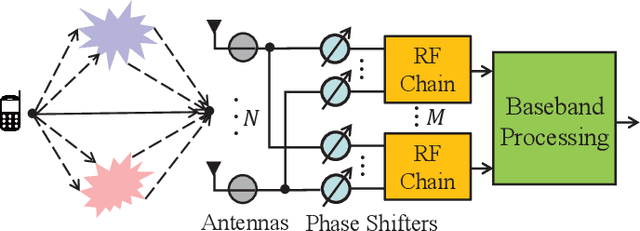
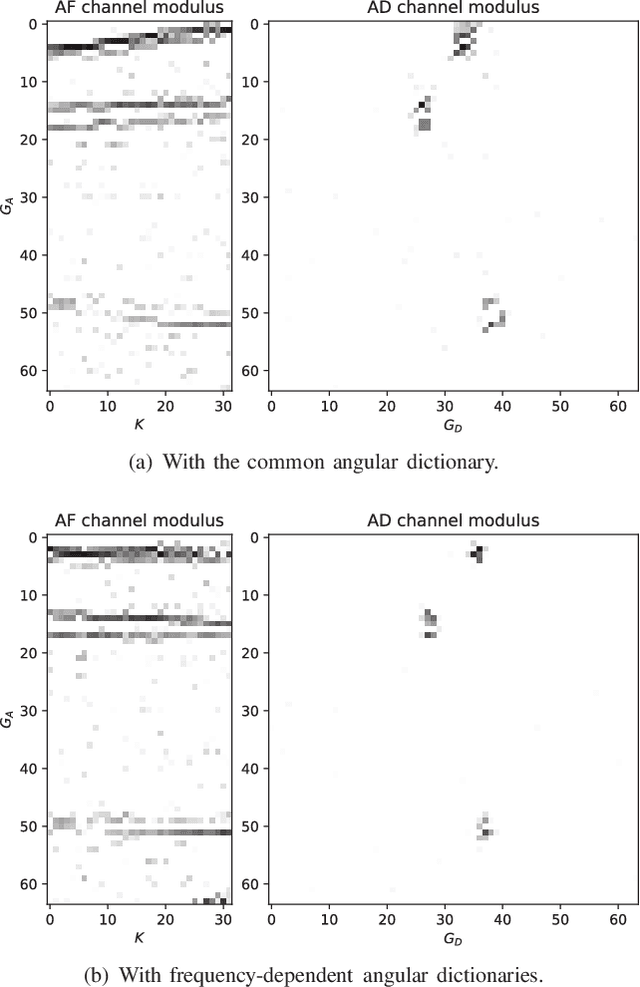


Abstract:In wideband millimeter wave (mmWave) massive multiple-input multiple-output (MIMO) systems, channel estimation is challenging due to the hybrid analog-digital architecture, which compresses the received pilot signal and makes channel estimation a compressive sensing (CS) problem. However, existing high-performance CS algorithms usually suffer from high complexity. On the other hand, the beam squint effect caused by huge bandwidth and massive antennas will deteriorate estimation performance. In this paper, frequency-dependent angular dictionaries are first adopted to compensate for beam squint. Then, the expectation-maximization (EM)-based sparse Bayesian learning (SBL) algorithm is enhanced in two aspects, where the E-step in each iteration is implemented by approximate message passing (AMP) to reduce complexity while the M-step is realized by a deep neural network (DNN) to improve performance. In simulation, the proposed AMP-SBL unfolding-based channel estimator achieves satisfactory performance with low complexity.
Wireless Image Transmission with Semantic and Security Awareness
Dec 01, 2022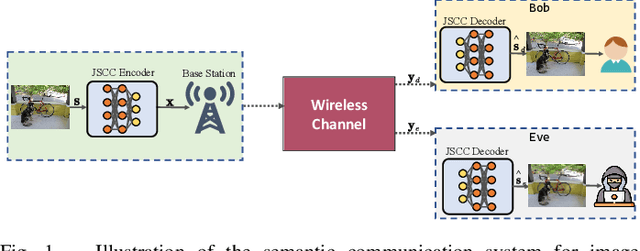
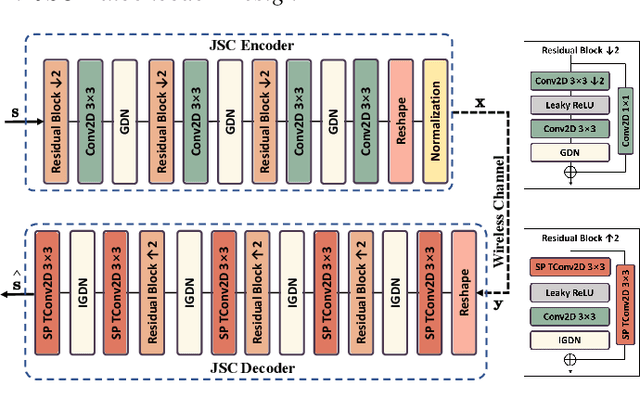
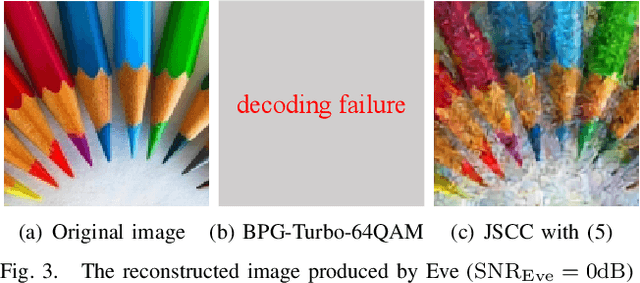
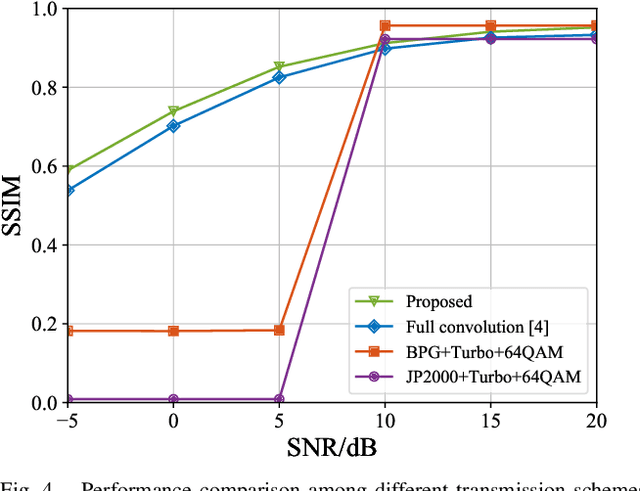
Abstract:Semantic communication is an increasingly popular framework for wireless image transmission due to its high communication efficiency. With the aid of the joint-source-and-channel (JSC) encoder implemented by neural network, semantic communication directly maps original images into symbol sequences containing semantic information. Compared with the traditional separate source and channel coding design used in bitlevel communication systems, semantic communication systems are known to be more efficient and accurate especially in the low signal-to-the-noise ratio (SNR) regime. This thus prompts an critical while yet to be tackled issue of security in semantic communication: it makes the eavesdropper more easier to crack the semantic information as it can be decoded even in a quite noisy channel. In this letter, we develop a semantic communication framework that accounts for both semantic meaning decoding efficiency and its risk of privacy leakage. To achieve this, targeting wireless image transmission, we on the one hand propose an JSC autoencoder featuring residual for efficient semantic meaning extraction and transmission, and on the other hand, propose a data-driven scheme that balances the efficiency-privacy tradeoff. Extensive experimental results are provided to show the effectiveness and robustness of the proposed scheme.
 Add to Chrome
Add to Chrome Add to Firefox
Add to Firefox Add to Edge
Add to Edge